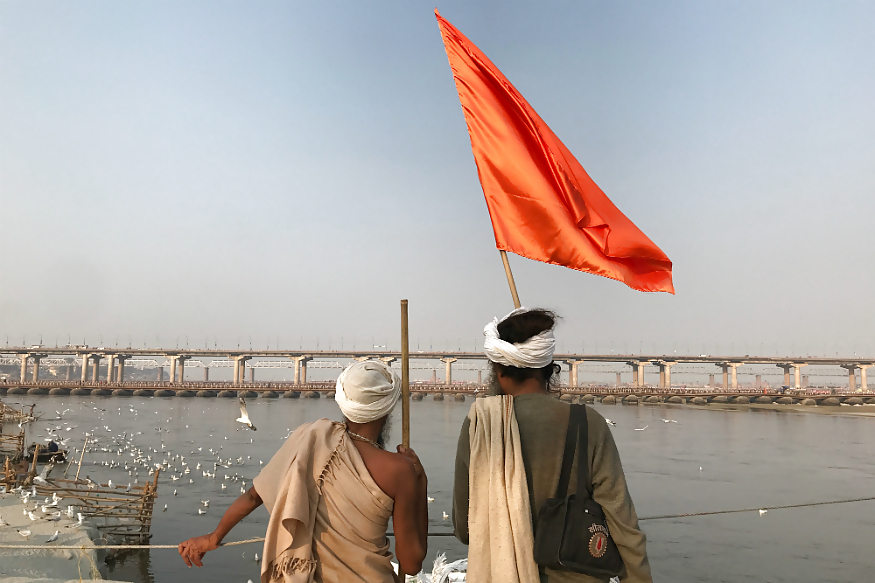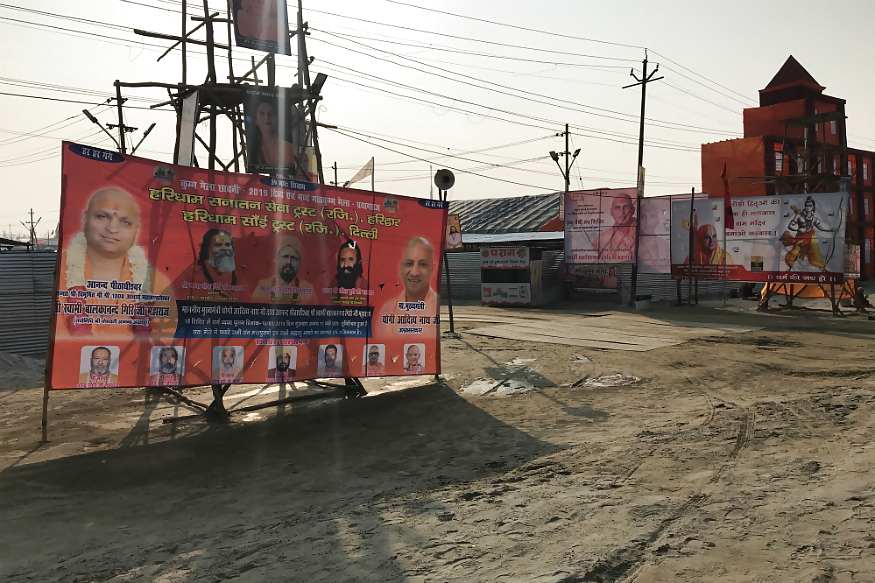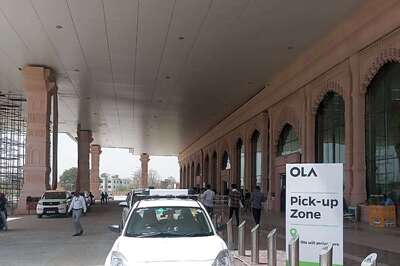
views
Prayagraj: On January 12, when Praveen Thakur of Haryana reached Kumbh, teeming crowds of pilgrims had already taken up the sprawling space in Kumbh Nagri, the makeshift city that will host more than 120 million worshippers over the next 45 days.
The thickly dotted tents were bursting with the tide of people marching towards Sangam, where the Ganga, Yamuna, and the mythical Saraswati Rivers merge.
Thakur, 32, squat, square-jawed and with a salt and pepper beard, will be participating in the Kumbh mela for the tenth year in a row. For the last nine years, his only reason to be part of the congregation was to wash off his sins by taking a dip at the confluence of three rivers.
This time, however, Thakur is in Prayagraj — the city of the congregation — for one more reason. He wants to be part of the journey where Prime Minister Narendra Modi wins the 2019 Lok Sabha elections and runs the country for a second consecutive term.
To achieve this, Thakur said, “the 45 days of Kumbh mela and what transpires politically during the time period is what matters”.
That’s because Thakur, a BJP karyakarta, believes that the road for the BJP to reclaim New Delhi in May this year will pass through Prayagraj, a city earlier known as Allahabad. Many believe the name change, part of the BJP’s Hindu identity drive, was implemented keeping in view the 2019 Lok Sabha polls.
These political overtones at the ongoing Kumbh aren’t just one man’s opinion. The issue of Hindu identity could very well remain at the center of the BJP’s narrative bid to win the 2019 polls, and Kumbh, for all the reasons, could be the testing lab. A serving example of this conjecture comes across translated in form of the frequent slogans that keep blaring from the countless loudspeakers atop the Akharas, where scores of Hindu saints and seers position themselves.
Fervent slogans like “Jo Ram ki baat karega, desh par wohi raj karega” (Only those who talk of Ram must rule the country); “Ram Lala, hum ayenge aur sansad mein kanoon banwaenge” (Ram Lala, we will come and make a law in Parliament) can be heard blaring from tents dotting the religious carnival — a reckoner that this 45-day-long religious gathering can achieve what it did for the Sangh Parivar 26 years ago when VHP swelled in strength, setting off a political wave that ended with the demolition of Babri Masjid. The 1992 events led to the emergence of the BJP as a political party that redefined the politics of social identity with religion, dislodging caste as the key metric.
For Thakur, however, this year’s congregation at Kumbh is not just about winning 2019. “Honestly, given the BJP’s do-or-die situation to regain power in the next general election, the significance of the mela this year cannot be downplayed,” he said.
He further explained: “If India has to become a ‘Hindu rashtra’, then Modi has to win the 2019 polls. And if he does form the government, then the road to building Ram Mandir will get easier.”
This confluence of rigidity on religion and politics is what the BJP might like to capitalise on before the country goes to polls this year. And to achieve that everything seems in place. The advertising blitzkrieg that has taken over the city is a testament.

Ascetics seen at the Kumbh Mela in Prayagraj.
Playing host to the world’s largest religious gathering, Prayagraj is coated with posters that feature Uttar Pradesh Chief Minister Yogi Adityanath and Prime Minister Narendra Modi side by side. Most of these posters and hoardings display words like Kumbh, BJP and 2019 prominently. The religious gathering has also drawn up an estimate of more than Rs 4,200 crore, making this year’s mega pilgrimage the costliest ever. The last full Kumbh Mela in 2013 cost less than a third of this amount. Add to that Adityanath’s decision to turn a smaller Ardh, or “half” Kumbh Mela, into a full version of the festival.
The message is clear. 2019’s one last pitch stop is a religious gathering of millions of Hindu pilgrims — an estimated 120 million people — from India and abroad, most of whom the BJP would like to believe will vote for the party.
Shailesh Yadav from Uttar Pradesh’s Faizabad district is one of them. In 1992, Yadav's uncle, a Karsevak, was killed during the communal riots that ensued after the demolition of Babri Masjid in Ayodhya. At that time Yadav was 10. Since then, the 37-year-old has been a Vishwa Hindu Parishad (VHP) foot soldier who believes that the biggest issue in the country that needs to be solved is the construction of the Ram Mandir. He hopes this year’s Kumbh could be the beginning of that.
“We are just months away from the general elections and the issue of Ram Mandir still hasn’t been solved. There is no better time than this to pass an ordinance in Parliament and build the Mandir,” Yadav said.
The issue of the temple has not just set the current Kumbh apart from the earlier ones; it also gives it an extra frisson. Besides the temple issue, another subject is spun deep within the narrative of sadhus and pilgrims: Hindutva assertion.
Maharaj Sidheshwar of Shri Nirvani Ani Akhada, Ayodhya, echoed what Yadav said. For him, the mandate for the upcoming polls will only be decided if the current government takes a decision on policies related to Hindutva. “India is the land of Hindu gods and this is the time to unite the Hindu Samaj. It is now or never,” he said.
This idea of Hindutva assertion at this year’s Kumbh, however, is not limited to the congregation area only. All over Prayagraj city, murals depicting stories from Hindu scriptures have been painted on walls, an exercise being watched with anxiety by the Muslim residents of the city known for its inclusiveness.
A Muslim local who runs a tea shop expressed concern over the paintings of Hindu deities but in the same breath he also explained how the city won’t succumb to any communal manoeuvrings.
“The authorities have painted murals of Hindu gods everywhere. It doesn’t affect us in any way as one has the right to practise any religious belief. But sometimes it feels like we aren’t living in Allahabad anymore,” the local said. Just like many others, he too, used the original name of the city that was changed to Prayagraj in October last year.
“First they renamed the city and now the politicians might even use Kumbh for their own political benefits. In between are the common people who will bear the brunt of any misadventure,” he added.
Though most residents of the city, which is minutes away from the congregation area, have no reason to complain as long as the “sanctity of the city is respected”, some don’t dispel the possibility of “outsiders” breaking the calm of the city.
Ram Mohan Tripathi, an advocate at the Allahabad High court, is one of them. Tripathi, 58, agreed that the gathering this year could be the beginning of a political battle and parties will try to stoke communal flames by referring to Ram Mandir among other issues. But the people of this city, Tripathi explained, won’t take part in any such activity.
“It’s the outsiders we are concerned about,” Tripathi said, referring to the Dharam Sansad, a meet of the highest decision-making body of Hindu saints and seers, that will happen at the end of January.
Earlier, the VHP backed by the Rashtriya Swayamsevak Sangh (RSS) had held a Dharam Sabha — the biggest congregation of Ram bhakts — in November last year. At that time, the organisers said the dates for the construction of Ram Mandir will be announced during Kumbh 2019.
The BJP is also hoping that successful conduct of the religious gathering can further its fortunes in a year when Modi will seek re-election as Prime Minister. During the ‘UP Investors Meet’ that was held last year, Kumbh 2019 was subtly marketed to the attendees. Modi even urged Yogi Adityanath to ensure that visitors from every country in the world should participate in the event.

Uttar Pradesh Chief Minister Yogi Adityanath's image is seen on a banner put up at the Kumbh Mela in Prayagraj.
This mega marketing for this year’s congregation, analysts claim, will help the BJP benefit to strengthen its vote share during the 2019 polls. To support this theory, Narayan Prakash, a political analyst from the city, pointed towards two main interpretations. His first assessment is that “this year’s Kumbh is going to give the Modi government a platform to assemble as many Hindu pilgrims at one place and assert his position before the elections as the only strong leader to lead the country in current times”.
The second one, Prakash said, “is the evoking of the symbolism of the congregation as an effort by the party to take care of its core voter’s basic religious freedom, which in turn could give the BJP large electoral dividends”.
But Prakash is also wary that possible events such as the political pitch around Ram Mandir at the Kumbh this year could very well metamorphose the city into an intense tinder box, ready to explode. In a state like Uttar Pradesh, that has long been one of India’s most tumultuous place — a nerve center of religious sentiments that usually reverberate across India — this fear is on everyone’s mind.
But BJP’s electoral dividends from the Kumbh have already begun. Or at least that’s what the pilgrims believe. One such example is the opening of Akshayvat and Saraswati Koop. Located inside the Akbar fort that rests on Sangam, the two places of worship were opened to devotees to offer prayers for the first time after 450 years.
“No government could do this for us. It is only because of Modi ji and Yogi ji that we are being allowed to see these sacred places,” a pilgrim said, adding that “the worshippers that will come to Kumbh this year should only vote for the BJP”.
That’s why, for a lot of people in Prayagraj, Kumbh is not just a place for the confluence of rivers; this is where faith and politics also flow parallel to each other, an idea that most of the people of the city seem to have seeped into their consciousness.
“Uttar Pradesh is an important state and has always shown a tendency for communal polarisation. At a time when the BJP is on the back foot, the party may need other issues to consolidate a uniform Hindu identity,” a local journalist, who works for a regional newspaper and has been covering the state’s politics since last 15 years, explained.
Yet, many dismiss the political enthusiasm over Kumbh as just a passing phase, saying that the new-found urgency during the election season is not a new thing. The display of faith in the city that once was known as Allahabad, albeit, has morphed itself into a new dimension. This confluence, without politics, remains incomplete.



















Comments
0 comment